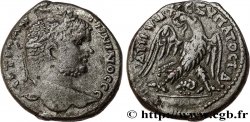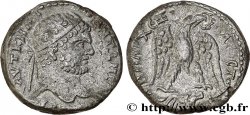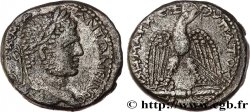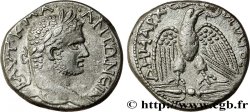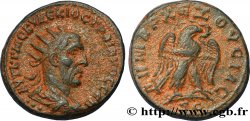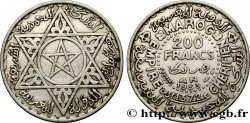bpv_318482 - CARACALLA Tétradrachme syro-phénicien
Nicht verfügbar.
Artikel auf unserem Online-Shop verkauft (2017)
Preis : 350.00 €
Artikel auf unserem Online-Shop verkauft (2017)
Preis : 350.00 €
Type : Tétradrachme syro-phénicien
Datum: 215-217
Name der Münzstätte / Stadt : Carrhae, Mésopotamie
Metall : Scheidemünze
Durchmesser : 25 mm
Stempelstellung : 6 h.
Gewicht : 12,48 g.
Kommentare zum Erhaltungszustand:
Minime usure de circulation sur le ventre de l’aigle
N° im Nachschlagewerk :
Pedigree :
Pedigree de rêve de la première grande série de tétradrachmes illustrés dans une vente de prestige, la majorité des exemplaires ayant fini en musées, cet exemplaire, qui est le 0820_028 de la base TSP, provient de la vente Cahn 71 du 14 novembre 1931, lot 994
Vorderseite
Beschreibung Vorderseite Tête laurée de Caracalla à droite (O*).
Legende des Averses AUT K. M. A.- .ANTWNEINOS .S-EB (Autokratoros Kaisar Markos Aurhlios Antwneinos Sebastos)
Übersetzung der Vorderseite (L’empereur césar Marc Aurèle Antonin auguste).
Rückseite
Beschreibung Rückseite Aigle debout de face, les ailes déployées un point au dessus de chacune, la tête tournée à droite, la queue à gauche, tenant une couronne dans son bec. Les serres sont placées au-dessus d'un bucrane à grandes cornes lequel est entre deux points.
Legende des Reverses : DHMARC. EX. UPATO. D., (Dhmarcikhs Ex Ousias Upatos D)
Übersetzung der Rückseite (Revêtu de la puissance tribunitienne consul pour la quatrième fois).
Kommentare
Les émissions de Carrhae (également appelée Harran, d’un mot akkadien signifiant croisement, certainement de routes), sont importantes. La ville étant directement sur la ligne de front, le trésor militaire y avait besoin de liquidités pour les troupes et la logistique.
Le plus intéressant de ces émissions est l’existence, tant pour Caracalla que pour Macrin, de deux séries distinctes dont l’interprétation est plus qu’intéressante car elle semble montrer que la ville était, de fait, dirigée et administrée par ses cultes principaux.
Les maigres renseignements disponibles indiquent un culte de Lunus, dieu mantique de la Lune mâle, qu’allait interroger Caracalla lorsqu’il fut assassiné. Les anciens suggèrent d’ailleurs que c’est la crainte de Macrin de voir ses complots dévoilés par le dieu qui précipitèrent le meurtre. Ce dieu, de son nom sémitique Sin, avait un temple de la plus haute antiquité dans la ville. Son nom est mentionné entre autres dans des traités de paix entre Mésopotamiens. Il fut pillé en 609 et restauré à trois reprises par les rois Salmanasar III, Assurbanipal et Nabonide et ne fut définitivement détruit qu’en 382 sur ordre de Théodose dans le cadre de l’éradication des cultes paiens pour laisser place nette au christianisme.
L’examen des symboles fait apparaître d’une part un bucrane de face entouré de deux points (ces deux points ne sont pas décoratifs, ils représentent deux étoiles, certainement celles du soir et du matin), d’autre part un croissant pointes en haut avec deux ou trois points en exergue, un astre rayonnant au-dessus de l’aile gauche de l’aigle.
Systématiquement, les frappes au bucrane sont liées à des effigies de l’empereur laurées alors que celles au croissant sont liées à des effigies radiées. C’est un cas où, Indiscutablement, lauré ou radié a un sens que l’on ne peut attribuer à une fantaisie du graveur car l’examen des deux séries montre bien que le même graveur a réalisé les deux.
On peut supposer, du peu que l’on sait des cultes locaux, que les séries au bucrane relèvent du culte de Malakbel, dont le symbole était un taureau et qui gouvernait les étoiles du soir et du matin.
La série au croissant serait celle de Lunus, ou Sin, qui est souvent représenté sur les bronzes avec un croissant de lune pointes en haut. Il serait lui aussi lié aux étoiles du soir et du matin mais aussi à un astre rayonnant (le Soleil ? Ceci pourrait expliquer, dans un système de pensée hiérogamique, le choix de la couronne radiée pour l’avers).
La seule chose dont nous sommes certains est que nous sommes en présence de deux cultes différents mais liés.
Si nous considérons comme valide l’hypothèse de la frappe de ces tétradrachmes de 215 / 217 comme une taxe au profit du trésor militaire, nous pouvons en déduire que les deux pouvoirs financiers de la ville étaient ces deux cultes, donc que la ville était administrée par des clergés.
Pour une intéressante histoire de la ville au travers des millénaires (Abraham y vécut !) voir http://www.livius.org/ha-hd/harran/harran.html .
On note que les sigma sont gravés en C.
Dans la base TSP maintenue par Michel Prieur, quatre-vingt trois exemplaires sont maintenant répertoriés dont en musées British Museum (2), Paris (3), ANS (3), Ftizwilliam, Doura/Yale (8) et Boston (2).
The emissions from Carrhae (also called Harran, from an Akkadian word meaning crossing, certainly of roads), are important. Since the city was directly on the front line, the military treasury needed cash for troops and logistics..
The most interesting of these emissions is the existence, for both Caracalla and Macrinus, of two distinct series whose interpretation is more than interesting because it seems to show that the city was, in fact, directed and administered by its main cults..
The scant information available indicates a cult of Lunus, the mantic god of the male Moon, whom Caracalla was about to interrogate when he was assassinated.. The ancients suggest, moreover, that it was Macrinus' fear of seeing his plots exposed by the god that precipitated the murder.. This god, whose Semitic name was Sin, had a temple of the highest antiquity in the city. His name is mentioned among other things in peace treaties between Mesopotamians. It was plundered in 609 and restored three times by kings Shalmaneser III, Ashurbanipal and Nabonidus and was not finally destroyed until 382 on the orders of Theodosius as part of the eradication of pagan cults to make way for Christianity..
Examination of the symbols reveals on the one hand a bucranium facing on, surrounded by two points (these two points are not decorative, they represent two stars, certainly the evening and morning stars), on the other hand a crescent with points upwards with two or three points in exergue, a radiant star above the left wing of the eagle.
Systematically, the bucranium strikes are linked to laureate effigies of the emperor while those with the crescent are linked to radiate effigies.. This is a case where, indisputably, laureate or radiate has a meaning that cannot be attributed to the engraver's whim because the examination of the two series clearly shows that the same engraver produced both..
From the little that is known about local cults, it can be assumed that the bucranium series belong to the cult of Malakbel, whose symbol was a bull and who governed the evening and morning stars..
The crescent series would be that of Lunus, or Sin, who is often represented on bronzes with a crescent moon with its points upwards. It would also be linked to the evening and morning stars but also to a radiant star (the Sun? This could explain, in a hierogamic system of thought, the choice of the radiated crown for the obverse).
The only thing we are certain of is that we are in the presence of two different but linked cults..
If we consider as valid the hypothesis of the minting of these tetradrachms of 215 / 217 as a tax for the benefit of the military treasury, we can deduce that the two financial powers of the city were these two cults, therefore that the city was administered by clergy.
For an interesting history of the city through the millennia (Abraham lived there!) see http://www. Livius. org/ha-hd/harran/harran. html .
Note that the sigmas are engraved in C.
In the TSP database maintained by Michel Prieur, eighty-three examples are now listed, including those in the British Museum (2), Paris (3), ANS (3), Ftizwilliam, Doura/Yale (8) and Boston (2)
Le plus intéressant de ces émissions est l’existence, tant pour Caracalla que pour Macrin, de deux séries distinctes dont l’interprétation est plus qu’intéressante car elle semble montrer que la ville était, de fait, dirigée et administrée par ses cultes principaux.
Les maigres renseignements disponibles indiquent un culte de Lunus, dieu mantique de la Lune mâle, qu’allait interroger Caracalla lorsqu’il fut assassiné. Les anciens suggèrent d’ailleurs que c’est la crainte de Macrin de voir ses complots dévoilés par le dieu qui précipitèrent le meurtre. Ce dieu, de son nom sémitique Sin, avait un temple de la plus haute antiquité dans la ville. Son nom est mentionné entre autres dans des traités de paix entre Mésopotamiens. Il fut pillé en 609 et restauré à trois reprises par les rois Salmanasar III, Assurbanipal et Nabonide et ne fut définitivement détruit qu’en 382 sur ordre de Théodose dans le cadre de l’éradication des cultes paiens pour laisser place nette au christianisme.
L’examen des symboles fait apparaître d’une part un bucrane de face entouré de deux points (ces deux points ne sont pas décoratifs, ils représentent deux étoiles, certainement celles du soir et du matin), d’autre part un croissant pointes en haut avec deux ou trois points en exergue, un astre rayonnant au-dessus de l’aile gauche de l’aigle.
Systématiquement, les frappes au bucrane sont liées à des effigies de l’empereur laurées alors que celles au croissant sont liées à des effigies radiées. C’est un cas où, Indiscutablement, lauré ou radié a un sens que l’on ne peut attribuer à une fantaisie du graveur car l’examen des deux séries montre bien que le même graveur a réalisé les deux.
On peut supposer, du peu que l’on sait des cultes locaux, que les séries au bucrane relèvent du culte de Malakbel, dont le symbole était un taureau et qui gouvernait les étoiles du soir et du matin.
La série au croissant serait celle de Lunus, ou Sin, qui est souvent représenté sur les bronzes avec un croissant de lune pointes en haut. Il serait lui aussi lié aux étoiles du soir et du matin mais aussi à un astre rayonnant (le Soleil ? Ceci pourrait expliquer, dans un système de pensée hiérogamique, le choix de la couronne radiée pour l’avers).
La seule chose dont nous sommes certains est que nous sommes en présence de deux cultes différents mais liés.
Si nous considérons comme valide l’hypothèse de la frappe de ces tétradrachmes de 215 / 217 comme une taxe au profit du trésor militaire, nous pouvons en déduire que les deux pouvoirs financiers de la ville étaient ces deux cultes, donc que la ville était administrée par des clergés.
Pour une intéressante histoire de la ville au travers des millénaires (Abraham y vécut !) voir http://www.livius.org/ha-hd/harran/harran.html .
On note que les sigma sont gravés en C.
Dans la base TSP maintenue par Michel Prieur, quatre-vingt trois exemplaires sont maintenant répertoriés dont en musées British Museum (2), Paris (3), ANS (3), Ftizwilliam, Doura/Yale (8) et Boston (2).
The emissions from Carrhae (also called Harran, from an Akkadian word meaning crossing, certainly of roads), are important. Since the city was directly on the front line, the military treasury needed cash for troops and logistics..
The most interesting of these emissions is the existence, for both Caracalla and Macrinus, of two distinct series whose interpretation is more than interesting because it seems to show that the city was, in fact, directed and administered by its main cults..
The scant information available indicates a cult of Lunus, the mantic god of the male Moon, whom Caracalla was about to interrogate when he was assassinated.. The ancients suggest, moreover, that it was Macrinus' fear of seeing his plots exposed by the god that precipitated the murder.. This god, whose Semitic name was Sin, had a temple of the highest antiquity in the city. His name is mentioned among other things in peace treaties between Mesopotamians. It was plundered in 609 and restored three times by kings Shalmaneser III, Ashurbanipal and Nabonidus and was not finally destroyed until 382 on the orders of Theodosius as part of the eradication of pagan cults to make way for Christianity..
Examination of the symbols reveals on the one hand a bucranium facing on, surrounded by two points (these two points are not decorative, they represent two stars, certainly the evening and morning stars), on the other hand a crescent with points upwards with two or three points in exergue, a radiant star above the left wing of the eagle.
Systematically, the bucranium strikes are linked to laureate effigies of the emperor while those with the crescent are linked to radiate effigies.. This is a case where, indisputably, laureate or radiate has a meaning that cannot be attributed to the engraver's whim because the examination of the two series clearly shows that the same engraver produced both..
From the little that is known about local cults, it can be assumed that the bucranium series belong to the cult of Malakbel, whose symbol was a bull and who governed the evening and morning stars..
The crescent series would be that of Lunus, or Sin, who is often represented on bronzes with a crescent moon with its points upwards. It would also be linked to the evening and morning stars but also to a radiant star (the Sun? This could explain, in a hierogamic system of thought, the choice of the radiated crown for the obverse).
The only thing we are certain of is that we are in the presence of two different but linked cults..
If we consider as valid the hypothesis of the minting of these tetradrachms of 215 / 217 as a tax for the benefit of the military treasury, we can deduce that the two financial powers of the city were these two cults, therefore that the city was administered by clergy.
For an interesting history of the city through the millennia (Abraham lived there!) see http://www. Livius. org/ha-hd/harran/harran. html .
Note that the sigmas are engraved in C.
In the TSP database maintained by Michel Prieur, eighty-three examples are now listed, including those in the British Museum (2), Paris (3), ANS (3), Ftizwilliam, Doura/Yale (8) and Boston (2)








 Berichten über einen Fehler
Berichten über einen Fehler Die Seite drucken
Die Seite drucken Teilen meiner Auswahl
Teilen meiner Auswahl Stellen Sie eine Frage
Stellen Sie eine Frage Einlieferung/Verkauf
Einlieferung/Verkauf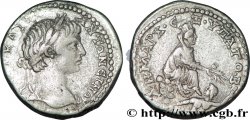
 Details
Details